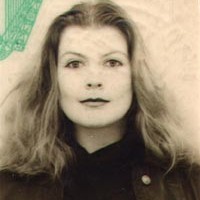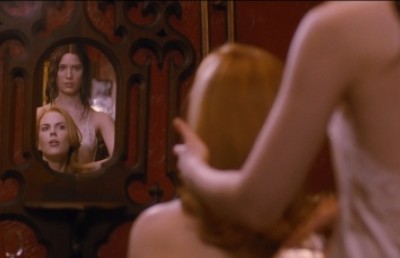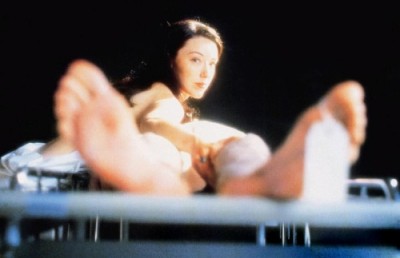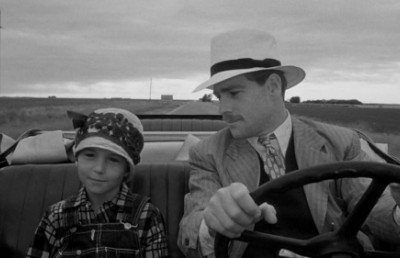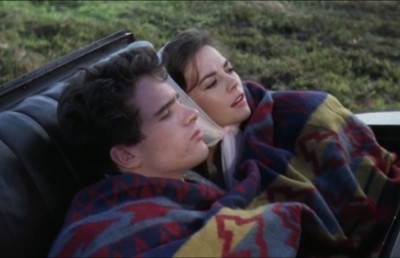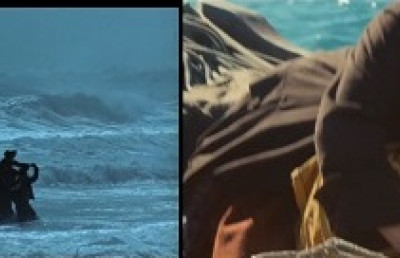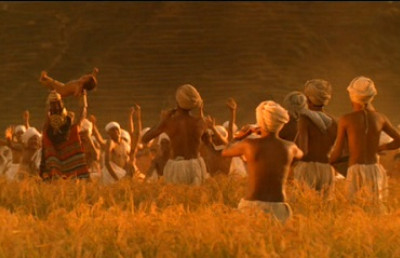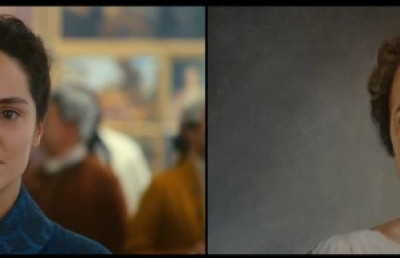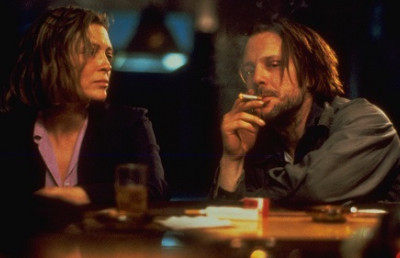The Mordant Geography of Desire in Barbet Schroeder’s More (1969)
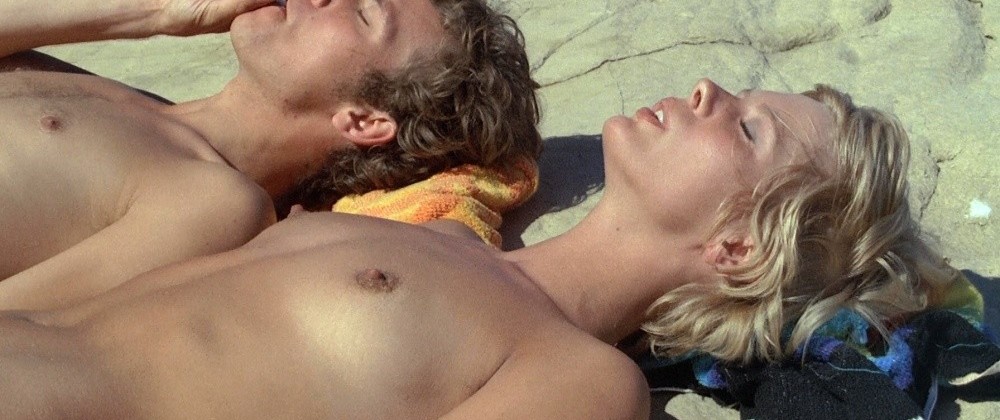
“I’ll follow the sun”
Based on a story by debutant director Barbet Schroeder, the 1969 film More is a classic study of ennui. Schroeder had worked as a producer, primarily for Eric Rohmer, for a number of years, and had led a peripatetic lifestyle since he was a child, courtesy of his father’s occupation. The film was made in the wake of the political fallout of 1968 and at the height of a phase in culture known for drug experimentation, so-called “free love” and an explosion of popular music which seemed to have a revolutionary coda. Now revolution was on the streets. In its own way, although not made as a critique of drug use, recreationally or otherwise, the film’s narrative can be read as a social study of a time in which alienation was fomented among the young, to devastating effect. An unholy mixture of James Michener’s forthcoming backpacking adventure, The Drifters (1971) and Céline’s Journey to the End of Night (1932) , Schroeder’s film remains a chilling experience. The references to these unconnected novels is subtle: Michener’s mammoth tome is a telling zeitgeist tale of contemporary decadent youth and its symmetry with that other period of political extremism, and consequent fascistic implications of laissez-faire, that centred around the crazed world of Berlin in the1920s; Céline’s novel is an overtly political work that channels the concept of purely evil characters and their inexorable trip to an inevitably doomed conclusion. Both are expressions of social failure, decadence and political extremism. Céline’s is clearly intended to be read as satire, although it has its critics. Neither is directly connected with this film, but the film could be read retrospectively as a gloss on their collective concerns about human behaviour and an interpretation of the links between the fallout from war, drug addiction, sociopathy and societal collapse, despite Schroeder’s consciously distancing the film from any kind of social comment. On the surface, it resembles a work by Antonioni: a journey to within by enigmatic protagonists whose predilections are a mystery for the average viewer, their motives unknowable. However, as Geoffrey Nowell-Smith states of the Italian auteur’s oeuvre, his typical narrative “is cast in the form of a sort of spiritual journey towards, ideally, self-discovery and the discovery of the world. The discovery may not be consummated; indeed the journey may end . . . only in destruction” (Nichols, 1976: 357). Schroeder’s first film as writer/director deviates from this strategy in having the protagonist openly declare his willingness to try anything, no matter how it ends. It is not therefore a drama of existentialist despair in the face of modernity. It is a work of self-abasement startling in its juxtapositions and wearying in its depiction of a life lost to boredom and permissiveness. A hymning of self-regard and degradation, insularity and obsession, ducking and diving to make ends meet, this journey into the void is perhaps more understandable now with distance, even though it was a popular hit at the time of its release. Based on a story Schroeder devised, it was co-written with Paul Gégauff, and dialogue was supplied by Paul Gardner, Eugène Archer and the lead actress, Mimsy Farmer. If it wasn’t an exercise in social discourse, it proved as powerfully as ever the acculturating role of film, proving a massive and critical success throughout Europe upon its release.
Stefan (Klaus Grünberg) leaves the cold wet climate of northern Germany after graduating in mathematics at Lübeck, seeking sensation and warmth, and fetches up after a spell of hitch-hiking on northern Europe’s rain-sodden motorways amongst petty criminals in Paris. His friend Charlie (Michel Chanderli) promises him a cache of money if they can pull off a theft at a house on the city’s outskirts. There, Stefan encounters Estelle (Mimsy Farmer), an American student who mixes him a margarita and whose money Charlie steals. “I fell in love at first sight with the blonde in the corner,” Stefan’s voiceover informs us. Stefan returns the 200 francs (with interest) to her at her apartment in the Hotel Louisiana, where she introduces him to a joint. She tells him, “It’s going to be legal in 5 years.” He says, “I don’t feel anything at all.” She assures him that he will and has sex with him. He notices cuts on her wrists which she says are the result of a dirty needle in New York. While she showers, he nuzzles the fur cuffs on a coat she has in her closet. She is travelling to Ibiza and says he can accompany her. He has to finish off a job with Charlie, and arrives there to discover she is not at the house belonging to an older man named Dr Ernesto Wolf, and instead finds her at a party where she appears to be indulging in lesbian sex with Cathy (Louise Wink) and sampling a variety of hallucinatory drugs. After petty quarrels, they retreat to a borrowed cliffside house where Estelle eventually goads Stefan into trying heroin after he finds her in bed with Cathy discussing “horse.” She has half of a packet. She says he can have one try, and describes how it makes her feel. She had been hooked on it in New York. He becomes immediately addicted. The 200 packets she has stolen from Wolf were, in fact, heroin, and now they are all gone. They wean themselves off of it by using LSD. Estelle informs him that he can pay Wolf back by taking work as a bartender in his hotel. When Charlie arrives to rescue him from Estelle’s clutches, Stefan goes for what ends up being his very last fix from Henry. He is buried at the village cemetery, with Charlie helping carry his coffin.
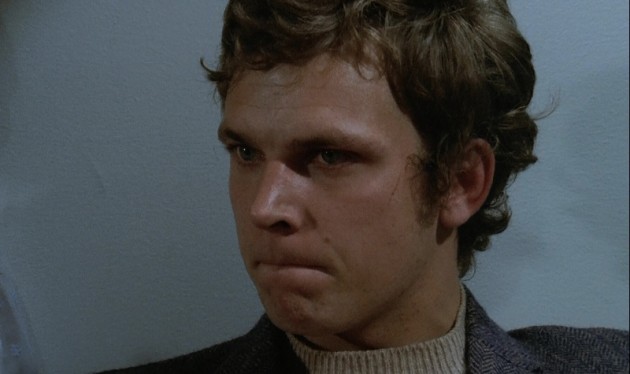
A German in Paris
“Good day sunshine”
The narrative could be termed a rites of passage drama. As Lucy Scher defines it, “the term ‘rite of passage’ applies to an event or ceremony that marks the transition from one stage of life to the next” (Scher, 2012: 18). The story’s structure centres on one principal narrative arc dedicated to the ritual of desire: Stefan’s desire for warmth and sunlight. He is removed from this path by what will eventually transpire to be his fatal encounter with Estelle. For Schroeder, Stefan died the first time he and Estelle have sexual intercourse, she closing his eyes afterwards as one would those of a corpse (Schroeder, 1969). The mathematical equation established is that sex = death. The immediacy of their attraction is not evident to the viewer, for whom the angel/devil, Estelle Miller, played by Mimsy Farmer (an actress whose charms may be more evident to men), is too obvious, so self-absorbed and flirtatious that a sixth sense tells us this can only be a chance encounter of the very worst kind. Indeed, the feral Charlie warns Stefan, but he is rendered oblivious by her mystery. We are therefore emplotted in the territory of dramatic irony, knowing, as Charlie does, that without help, Stefan is doomed. The ritual that inscribes his desire is figured by Estelle’s first act towards him –she prepares a margarita and licks the rim of the glass before dipping it in salt. It is a heady introduction. The core of the film’s narrative rests on the physical principle that opposites attract: Estelle’s surface energy is active and enticing, drawing out the more mordant, dispiriting, lo-fi appearance of Stefan. Secondly, the desire for sunlight is conjoined with Estelle and drugs. Her preparation of a joint necessitates the shutting out of light from her apartment window and it occurs prior to their first having sexual intercourse. She closes his eyelids as though he were dead. This is less happenstance than filmmaking strategy. Estelle then departs for Ibiza, scene of holidaying and sunlight. She is now associated with the giving of physical pleasure and the control of light, as later shots in Ibiza correlate.
The dramatic balance of Stefan and Estelle is also directly demonstrated by the film’s staging, or mise-en-scène. Her refuge is away from the mainland of Europe, in the blazing sun, part of the continent’s rocky outcrop, closer to the centre of the universe itself, unhindered by tower blocks or subterranean railway journeys. She had a map of the brain on the wall of her apartment in Paris: uncharted territory. The shot cuts to a seagull diving into seawater and Stefan’s observation of the sea from the prow of a ship then disembarking at a small port. This is a very different path to the big chill.
It becomes apparent that Estelle is the protégée of Dr Ernesto Wolf (played by the happily named actor Heinz Engelmann), whose origins Stefan never questions. Perhaps, being German, and being aware of the utter failure of de-Nazification in post-war West Germany (due to the sheer numbers, the Allies simply gave up, and the new government rehired Party members to their former positions, while anti-Nazis lost their pensions) he doesn’t even wonder why this man of a certain age is living in exile from his homeland and in apparent luxury. (He is, of course, a drug dealer.) Living on the periphery of Europe, isolated from the rule of law and the fallout from post-war guilt, the normal sense of civic duty is something for the mainland. The disintegration of Stefan’s identity (an identity which we already sense is incomplete from his gullibility and easy ways) is played out in a landscape of misrepresentation. The visuals are outstanding and distancing. Hyper-aware of the film’s potential impact as a demonstration or critique of failing social movements, Schroeder seems anxious to offset the potential attractiveness of the location with the minutiae of addictive behaviour and its devastation, dissociating the action from any kind of recognizable social or cultural context. He specifically does not refer to les évènements or political intention. In fact, by taking the film’s protagonists outside of the city and the scenes of cultural revolution, Schroeder is making a point. And yet he was creating a cartographic imaginary, linking drug addicts and dealers and the secret locations of Nazi iniquity across Europe which writers like Frederick Forsyth and Sam Bourne (aka Guardian journalist Jonathan Freedland) have (made) known for decades: former Nazis gather annually in Europe’s top holiday spots such as Ibiza, Alicante and Portofino, to name but a few, at the beginning of the season, and cheer their good fortune at having escaped retribution, the Allies having long given up the chase. Thus the point is made – calling him “Wolf” by itself signifying Nazidom (their familiar alias), plying his trade, in a different way, in a different climate.
The Hotel Del Negro is a den of iniquity which propels Stefan through the village immediately after his arrival and failure to locate Estelle, racing through village coffee shops and streets as church bells peal for Mass. He finds Wolf playing a knife game, proclaiming it an act of sentiment, “thinking of old times.” Initially, Wolf affects not to know Estelle well. It is later established that their relationship is likely sexual. When Stefan asks Henry about him, he says, “Everything about Wolf interests me.” But Henry claims that nobody on the island knows him well – but he “does a lot of things.” He then reveals his suspicion about the hotel: “I think it’s a cover. I think he ran into some trouble after the war and I think it’s some sort of ex-Nazi thing based in the Mediterranean.” Old habits die hard. Schroeder is therefore mapping related political cultures across time and space. His placing of Wolf at the centre forces the film’s ideology to crack wide open, unhinging any statements to the contrary. Then Henry gives Stefan a purple heart.
The disintegration of identity, social or personal, is offset by virtue of the beautiful locales and the un-ordinariness of the chosen existence. Desire for warmth is replaced by the desire for sex; the desire for sex is replaced by the desire for drugs; the desire for drugs replaces everything, even self-discovery. By modelling the story on the Icarus myth, Schroeder self-consciously sets the film in a place of such overwhelming beauty that the fall from grace cannot but be rendered infinitely ugly. In one sequence, Stefan loses self-control and Estelle’s atavistic desires are thereby amplified in his degradation. He is no longer an independent persona; he is now to be understood as a kind of extension of her ego, a functionary, a mule, the masochist to her sadist, the passive to her aggressive, the Earth to her Sun. In terms of linguistic binary oppositions, and in keeping with the analogy with Lévi-Strauss’ findings, Stefan’s symbolic (and actual) journey is the mythical one of narcissistic consciousness to unconscious in this Metzian desire machine. When Stefan first sees Estelle on the island, he remarks that she looks strange. She explains away Wolf as a friend of her father’s. And she declares to him, “I warn you: I want more . . .”
“Ritual de lo habitual”
The story pattern of ritual and transgression is established upon Stefan’s first encounter with Estelle at the house in Paris. When they meet, she prepares the ingredients for a margarita and licks the edge of the glass, preparing it for the salt necessary for the rim. At their next meeting in her apartment, she carefully closes the curtains, prepares a joint and has sex. Later in the film, the ritual surrounds ingesting hallucinatory drugs during a version of an orgy. When Stefan finds Estelle in bed with Cathy at their house, he hears the word “horse,” has sex with them both, and, later on, Estelle explains its meaning in the way that it makes a person feel, and more or less goads him into trying heroin for the first time. This ordering of life, or re-ordering of what might have been a regular, codified existence with obligations and responsibilities, takes place in scene sequences that mimic and replace the ordinary. The religious element is clear from the several shots that incorporate a crucifix, a normal signifier on a Catholic island such as Ibiza. Estelle is associated with bounty, richness, control. Her life is seen as something tribal – at the port in Ibiza, a drug is passed around from person to person, linking Estelle with something primitive. It is yet another ritual. And at dawn, cocks crow outside, another religious warning preceding gusting winds. She shows him around the village and he sees a tunnel and asks Estelle where it goes. “To the sea,” she responds. Her association with the elements is complete.
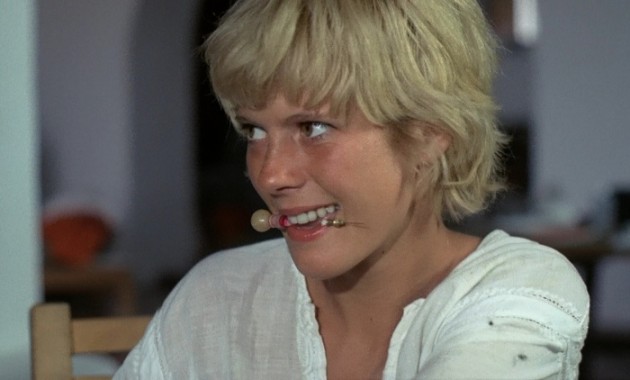
The Smiling Face of Heroin
Life at the house where they take refuge has the patina of normalcy – save for the naked fishing. Stefan regales Estelle with a story of men who worship the sun and go blind and die, essentially telling us what is going to happen to him. The sun is then captured with a flare on the lens. They have sex, wash, do the laundry, and then Stefan goes unaccompanied to the market, explaining in the voiceover, “Estelle just wouldn’t go outside. She was scared of everything except our house.” Ritual also takes the form of cod spiritualism – Stefan and Estelle stare at the sea from a cliff-face, humming “Om,” and then there is a cross-cut to them naked in a seated coital embrace, her staring determinedly at the camera and crossing her arms around his back as if she is taking possession of his very self. Juxtaposed with this is the sunrise. It is not perverse therefore to infer that “Om” conjures the word “ominous” in this bifurcate version of life as it is lived, as opposed to how it might have been, the will to power being activated as a force of nature. Estelle occupies a dual function in the story – we see what she is, Stefan does not. We are always one step ahead, which removes the possibility that the film activates any kind of suspense. The desire to touch, the desire for warmth, sensual embrace and sexual possession form a part of the ritual of destruction initiated by this fatal attraction of opposites. Ritual demands an ultimate sacrifice, and it is Stefan’s willing surrender to everything demanded by the increasingly savage Estelle that leads him to this juncture. Self-gratification and denial are masked by mind-altering drugs. The “trip” which commenced this journey was never about self-discovery, it was about a maths student looking for a way out.
Estelle represents asymmetry. In terms of ritual, this has a particular effect (and affect). As Sam Rohdie reminds us, “In ritual, events originally asymmetric – sacred and profane, faithful and officiating – are conjoined, de-differentiated, constituted as an ‘organic’ whole structure. It is in this sense that mythical thought, and perhaps art too, is a liberator.” (Rohdie in Nichols, 1976: 471) Estelle conjoins the film’s aesthetic of ritual to myth, using Stefan as her vehicle of expression, her power deriving from his willingness to submit. The structure of the masochistic drama – “fantasy, disavowal, fetishism, and suspense”– are not present in their entirety for More to function as a classic film drama (Studlar in Nichols, 1985: 605). Suspense is sacrificed for the overwhelming effect of Estelle’s “spider woman” impersonation. Desire is here replicated as an oral pleasure, the drugs operating to codify Estelle’s solicitude, her fake maternal positioning. The final gratification of death is therefore amply identified in this subversive tale. Female plenitude is replaced with a lack or void of divine proportion. As Gaylyn Studlar writes,
Masochistic desire depends on separation to guarantee the structure of its ambivalent desire. To close the gap, to overcome separation from the mother, to fulfil desire, to achieve orgasm, means death. The contracted, mutual alliance of the masochistic relationship guarantees distance/separation. Unlike sadism, which depends upon action and immediate gratification, masochism savours suspense and distance (Studlar, 612).
Ironically it is Estelle who declares of Stefan that he is “Devil! Devil!” and retreats from him during the LSD trips they indulge in to wean themselves off heroin. She is looking at her mirror image. Later, she says: “It wasn’t you, it was me. I guess I didn’t like myself so much.”
“Golden brown texture like sun, Lays me down with my mind she runs”
The desire for ritual transformation is expressed on a rites of passage road trip, which takes a circular shape, leading to death, the ultimate destination. In this process, certain rites are observed: the commencement, on the rain-strewn motorways of Germany; the encounter with a herald, Charlie, who warns him not to be taken in by Estelle, who has ruined other men; the physical journey to the sun which appears to have spiritual implications in this time of hippiedom; the meeting with Henry, who bookends the drama and will eventually supply Stefan with the killer “horse”; the specific refusal of enlightenment (preferring to stay indoors, succumbing to drugs, out of the sun’s rays); and therefore the denial of the anticipated trajectory with the variation now being that of mythical self-delusion. Estelle’s position as muse to Stefan’s initiation and maturation turns into its opposite, the Angel of Death. She herself is the protégée of a drug-dealing Nazi, a political force which occupied a similarly symbolic and actual role in European history. The inner space superficially being sought by such a quest for warmth is thrown into doubt by the spatial compression of the island, where religious rituals are consciously opposed by drug-taking rituals, and lack of consciousness replaces the desire for a higher consciousness. Filling the void of personality with a drug that simply stretches out nothingness into nowhere-ness, the island becomes a liminal space. It is a hideout for a political fugitive; it is a place undisturbed by law and order and therefore a safe haven to indulge an illegal drug habit; it is, then, as Somerset Maugham once said of Monte Carlo, “a sunny place for shady people.” The choice of Ibiza is an apposite one for this infinitely metaphysical drama, linking the physical with the psychical, nature with its damnation. “I was in harmony with the world for the first time,” claims Stefan, after the LSD trip. “I even felt a certain warmth for those unbelievable tourists. They were human beings and fellow countrymen. I think Wolf was moved by them, like me.” His enlightened statement is a brief burst of the unfamiliar – empathy.
This luscious location for the senses paradoxically dulls the appetite for real (ie, conscious) life. As Stefan overhears Estelle telling Cathy when he’s found them in bed together, “It’s different here.” After he sleeps with both women and Estelle reveals to Stefan that they’ve been doing heroin, his voiceover tells us, “Cathy left the next day. The confusion she left behind her scarred both of us.” The following day, he finds her using binoculars, espying her splayed and sun-drenched on a rock above the sea. He carries her home. She admits that she has started using again. Their unnerving habit is contrasted with a life outdoors, swimming smoking hookahs, lying in the porch. “You must admit there’s a spell in that junk,” she tells him. “This makes you feel very beautiful and alive,” she says of pot. “Horse just makes you feel very comfortable.” He protests that people who take horse just want to escape life. He becomes one of them. The schism caused by Estelle is actuated through her double life. For Stefan, she represents a gateway drug ad infinitum. There is no negotiation in their relationship, no give and take, winning and losing; this is a game of infinite one-upmanship, even if Stefan is unaware of it. “Hippies put horse down,” she moans. Stefan says, “So you are an exception.” And Estelle agrees that she is. She cuffs his arm and shows him how to shoot up. He falls down on impact. Then Stefan stays at home, and she is the one cycling to the village for supplies, making a deal with Wolf.
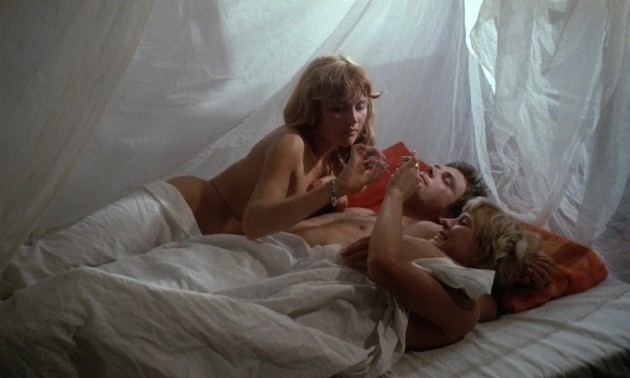
Drugs and a Threesome
According to Sam Rohdie,
…ritual and movie structure exist as delimitations of choice. Action is as meaningful as choice within a determined range of possibilities. But that action is never simple, nor is its appeal primarily to intellect – it calls into play the various levels of reality and of abstraction impacted in the code and the entire range of functionally inter-related associative meanings. Action both expresses and calls into question the ‘hidden structure’ of the movie whose immediate impact, often as direct ‘real’ experience, is the result of a dissolution of structural categories, confirmation of Bazin’s dictum: ‘toute la réalité est sur le même plan’” (Rohdie, 473).
In More, abstraction is conjured both in character and textural aspect, primarily in the exploiting of the location. While conscious will is expressed only by Estelle, the mathematically inclined Stefan, is unbalanced by the forcefulness of her persona, which captures the indexical, the iconic and the symbolic in the one form. The structure of the film is not so much a seesawing effect of behavioural tics as a gravitational pull into the orbit that Estelle controls (while she herself is something of a subject to the will of Wolf). The binary structure that Lévi-Strauss’ anthropological findings spurred in semiotics and Sixties film theory is here obfuscated by the uneven keel of the dramatic fulcrum. In Metzian terms, More is an example of pure cinema, a displacement of desire and therefore an expression of the death drive (Johnston in Nichols, 1985: 320). The winter sees Stefan and Estelle hooked again.
“At the beginning of the season, I’ve been waiting so long to be where I’m going in the sunshine of your love.”
Ritual here becomes a strategy of avoidance —a means of blocking confrontation (a move synonymous with marriage, perhaps) – sexually charged antics becoming replaced with the mind-numbing chores of household maintenance and daily routines of shopping, cooking, eating, washing, laundry. When Charlie first befriends Stefan, they indulge in card games before embarking on a series of petty crimes. Stefan and Estelle’s rituals – or sacred actions – start with the preparation of a drink; then a joint; then a heroin shot. Life revolves around ritual. Ritual becomes engrained and then finally unconscious, automatic, thoughtless and perhaps pointless. It is a compensation for thought and expresses a desire for control without actuating any (this is why Marx declared religion opium for the masses). For the drug user, the recreational use becomes habituated, ritualistic and regular, and is ultimately about self-gratification to the detriment of any sense of self-worth or usefulness. In More, drugs represent the satiety of a desire that has no affect and is merely indicative of a lack of conscious will. This descent is metaphorically rendered as a journey – starting on a rain-sodden motorway in Northern Europe where Stefan covers his head with a newspaper to protect him from the downpours, and continues on hitch-hikes on lorries, first to France, then London. His voiceover declares his need for warmth, but he has no interest in anything current and we never again see a newspaper or any reference to anything social or meaningful. Stefan’s own personal journey –into a version of Hell– is laid out for him in his demon Other, figured by the Sun, represented not just by Estelle’s sense of display, but by the sun itself, the blessed-out blistering experience to be had island-hopping in the Mediterranean. The sun is the centre of the drama, around which everything revolves. The title sequence is a series of images of the sun, with repeated camera flare and tracking shots through clouds to it with its intolerable burnt out appearance, then passing behind blackened cloud again. When we first encounter Stefan, his voiceover states, “I had imagined this journey as a quest. I had finished my studies in May and if I got burnt that was okay. I wanted to be warm. I wanted the sun. And I went after it.”
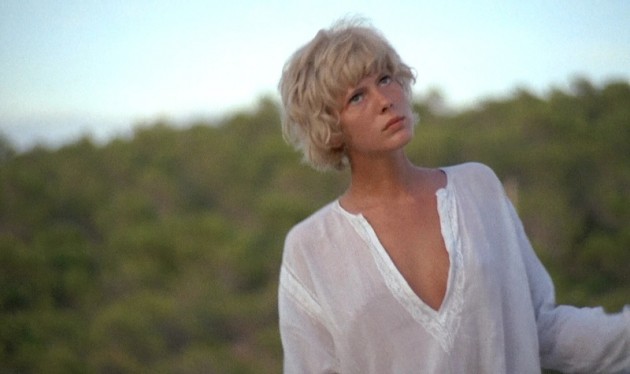
As pale as the sun
“You can’t always get what you want”
Ibiza has long been celebrated as a location for experiential holidaying. The metaphor of the island off Europe, soon to be a hedonist’s paradise, is not lost on the audience. Free of political pastness, away from the presentness of conscious activity, malaise and drug addiction replaces the ritual of everyday life, responsibility and a civic existence. Gratification has replaced intent, and the harmony represented by nature is strikingly at odds with the inner-direction of the drug addict, only looking for his next fix. The island is a byword for lawlessness and decadence. The energy associated with ritualistic behaviour is negated with the pointlessness of the junkie’s existence which feeds off the vacuum of his self. Ritual of seduction becomes eclipsed by a slide into oblivion –the sleep of heroin closely connected with the relief of death, the numbing paralysis of thoughtlessness in an alternative society with an avowedly religious appearance but boasting areas and passages which literally plunge Stefan toward darkness. Estelle ultimately mutates from harbinger to actor. Clad predominantly in loose-fitting white clothing, she cuts a swiftly moving figure, her mind working quite as fast as a sprite’s, calculating, working against Stefan, trying to make for herself a better situation than the present one in which she finds herself. In terms of story structure, she could be described as a helper to Wolf, the villain, and a false guide to Stefan. She is associated with wind, fire and water; he is more grounded, and yet more malleable. When he asks her if she loves him and she tells him, No, he throws her into the sea.
“Here comes the sun”
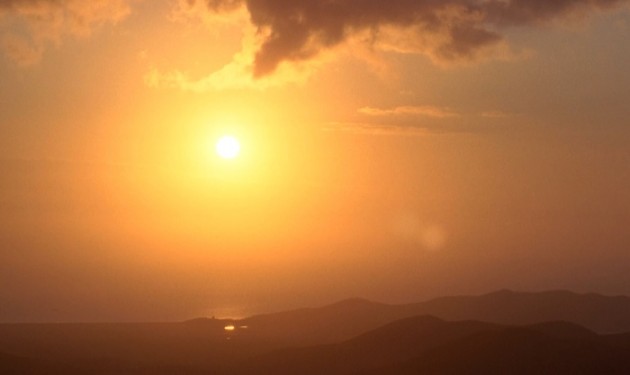
The music was the first soundtrack album produced by Pink Floyd (they would later contribute memorably to Antonioni’s American venture, Zabriskie Point, made the following year) and it was only a soundtrack in the diegetic or ambient sense. It was an exercise in realism and, as Roger Waters stated,
… he didn’t want a soundtrack to go behind the movie. All he wanted was, literally, if the radio was switched on in the car, for example, he wanted something to come out of the car. Or someone goes and switches the TV on, or whatever it is. He wanted the soundtrack to relate exactly to what was happening in the movie, rather than a film score backing the visuals (Quoted by Kendall, 1984).
Ritual is composed of repeated actions to the point of meaninglessness (hence the Buddhist chanting), and we now know it is a component of obsessive compulsive disorder – in other words it is symptomatic of mental illness. Ritual without a religious or faith base (a brilliant invention, according to Jung) therefore has a sinister dimension, hinting at issues of control (or lack thereof) and the need for mastery of the environment and the self. In essence, it is a wonderful form of delusional activity. Situating this metaphysical drama in a primordial landscape almost entirely free of civilizing influences or the kind of vast over-population familiar from modern cities suggests the narrative’s desire to re-orient the protagonist in an environment which links him to his inner world –in other words it is a physical representation of his psyche. In More, the quest for consciousness, enlightenment and knowledge, 60s-style, is actually a descent into the unconscious, oblivion, ultimately death. While not an overt satire –Schroeder did not wish to make any social comment in this film– Estelle’s descent into the embodiment of the mythical savage is figured in the frequent shots of her in the landscape, peroxided to the point of becoming part of the island’s rock face. The sun’s halo becomes increasingly sinister as her arc seems infinite while Stefan’s decreases in its orbit. The sunlight seems to gift Estelle with power while draining Stefan of the will to live. Heroin, it seems, has equal power with nature’s most dramatic elements; the planet now revolves around a drug called horse. He is clearly the masochist in her sadistic drama. The sun is no longer the source of warmth, it is an omen. In Julia Kristeva’s interpretation of the play of desire in the text and the role of the feminine in the symbolic (the system of signification), she insists upon the linking of “throwing out,” a kind of negation, which imbues the feminine with the concept of the repressed. The pleasure-death principle is essential to the operation of the textual and we can see this figured in Estelle throughout More in a castrating process the logic of which is the eradication of the phallus (Johnston, 325).
The texture of the film derives from the decentred attitude towards the environment and its fragile geometry which distorts the dramatic lens and fractures Stefan’s personality. The landscape may be all but forgotten in this ever decreasing circle, but it is intensely rendered with the rock formations, the whitewashed walls, the busy market place, the waves of the sea brushing the marina’s walls, framed by the giant crucifix symbolising faith. Juxtaposition of the cold, damp, busy people-oriented life of the cosmopolitan city of Paris and the rain-swept motorways of Germany and Belgium represents not just a geographic shift, but a metaphysical expression of desire that goes beyond national or notional boundaries. Estelle’s existence in both landscapes is a reinforcing expression of the asymmetry that dramatically alters the balance of Stefan’s life. As Estelle seems to become stronger in the alien landscape, and yet alienated, Stefan seems increasingly at odds. She becomes bleached out in the sun, dressed in white, skin tanned, hair whitened, yet he cannot cast off his origins or his looks in quite the same way. The drug makes her more of herself while he becomes lessened by his dependency and her influence. Her disturbing sensuality unbalances Stefan’s essence. Is there anything more distracting than a woman whose attributes you fail to understand as she lures a man to his utter destruction? (When Charlie finally arrives in Ibiza he is unimpressed by her physicality and says she has thick legs.) Perhaps the most disturbing element of the drama is the anomie of the protagonists. Neither Stefan nor Estelle could ever be construed as heroes, in any sense. They are utterly unlikeable people, even contemptible. They have no human empathy and therefore could both be described as sociopaths. This hedonistic journey is actually a spiral of nihilism and an enactment of primal longing.
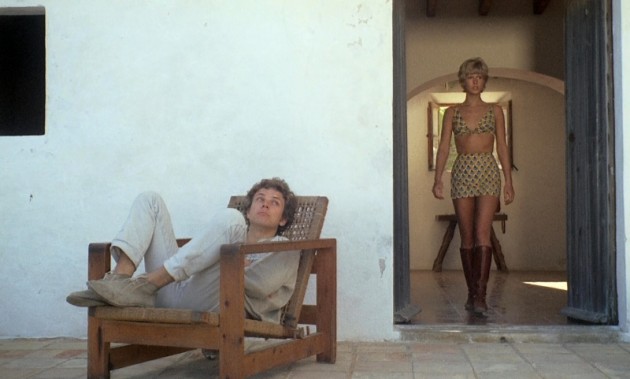
The re-imagining of ritual and its re-enactment in different spaces (sunnier, warmer, closer to the Equator and hence a more perceptible equilibrium) does not achieve the anticipated balance either emotionally or dramatically. Schroeder’s signature themes – the structuring collision of opposites destined to destroy one another– is the opposite of romantic comedy. This is more an over-determined tragedy with the fundamental role in the narrative of the mythical replacing regular codified drama. Sadomasochism is an element that threads through much of Schroeder’s fictional work and it is clearly a structuring form here. The liminal and transitory nature of the experience –a dislocated and fragmentary gloss on a failed social experiment centring on the drug lifestyle – is a surprisingly closed outlook for a supposedly revolutionary culture which was still “happening.” For many, the hippie ideal did not reach its zenith until the early Seventies, at which point it had become a more generalized form, assimilated into the mainstream, when one could buy hippie wigs for a couple of dollars at Woolworths and bell-bottomed jeans were common even amongst the middle-aged. However, Ibiza is a signifier for a wider culture – a trope for the extremes of Sixties hedonism, coupled with passivity and malaise, the reductio ad absurdum of a movement towards darkness. This is writ large in the tragic irony of this narrative of manipulation, taking its principals and moving them slowly to their inevitable positions in an excruciating enactment of the throes of death.
“Although it was winter the sun was shining like on a hot summer day”
The ritual necessary for male survival – male bonding – is re-enacted to ill-effect: Charlie’s warning going unheeded, Stefan does not leave Estelle, or the drugs, he clings onto the myth that now engulfs him. Ritual is replaced by meaningless repetition, as empty as the irrelevant Buddhist chants they have cast into the open air between shooting up. LSD provides an interlude of release and a connection to a form of nature that exists beyond the void, but it is a brief if lyrical episode. We might perhaps say that the vacuum of the 1960s allowed for people to stop believing in those creeds and values which informed the Western society that created them and now they will believe anything, including a dubious guru whose cult is founded on mind-altering substances and whose infamy and personal charisma is fuelled by the devilish properties of fascist politics. The film’s transformational arc is again reinforced in its drive towards death and Stefan’s verbalised embarkation upon a quest for experience – wherever it may lead. “How wonderful is Death. Death and his brother Sleep!” Shelley wrote of Thanatos and Hypnos: they are the narrative’s guiding forces. The narrative drive is established not just in the story elements, but in the mise- en-scène, the halo effect being far from beatific, the black beckoning clouds a signifier of what is to come.
The final stages force a subtle rewind on the part of the viewer through the sequences of desire that have been played out thus far. Charlie arrives on Ibiza to find his friend, as anticipated, deeply in thrall to the heroin which Estelle clearly introduced to her other male casualties. Stefan failed to heed his warning, now Charlie is here to bring him home to mainland Europe, where he belongs. Stefan complies but insists that he go for one last fix from the mysterious, bearded Henry (Henry Wolf) who gives him double the dose and says not to take them both at once. Stefan takes them together, in the tunnel that leads to the sea, and staggers out of it, the large crucifix framing the image, replaying the action from earlier in the story. He is found there, dead, like a rat. His last fix has had the devastating effect the first one signified: fatality. The coffin carrying his body is carried out from the other end of the tunnel. Charlie helps carry it in a procession to the graveyard as the church bells peal. The structure of ritual in religion is that it demands an ultimate sacrifice, and Stefan is that sacrifice. He has given up his conscious existence and now he has been felled by physical addiction that functioned as a placebo for human warmth.
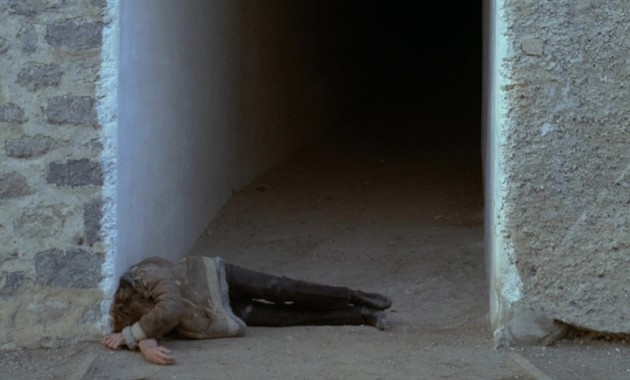
Dead at Journey’s End
The end of the 1960s hippie dream had yet to be played out in Ibiza, which is yet a centre for decadent drug use and repository of the played-out, junk-filled lives of society, revelling in a carnival atmosphere provided by night club owners, DJs and elements of the aristocracy and its hangers-on, in their very modern pilgrimages for eternal youth, everlasting highs and a rocky island space in which to be permanently “spaced out.” In interview, Schroeder said he consciously made a film about the dark side of the sun – “On his way he has submitted to all the rites of initiation and mystery” – and the primitive setting amplifies the concept of a coming together with Nature. Stefan died the first moment he had sex with Estelle. And in the end, Schroeder claims that in burying his hero he was getting away from his own old life (Schroeder, 1969). The picture created by Schroeder 46 years ago seems oddly prophetic: the birth of a movement away from convention is inevitably partnered with a death that at its core symbolizes in its unmarked grave an unremarked gesture from society back to the persona-free, dead junkie: Keep Out. The porosity of life and ritual melts into the earth, the ancient ritual acknowledging the modern avant-garde. Ashes to ashes, dust to dust.
“Lead us not into temptation”
The film’s poetic is both representational and actual. The embrace of heroin and the lure of death are savage and relentless, the pull of both as embodied by Estelle is formidable. The equilibrium demanded by any dramatic narrative is simply expressed in this rigorous narrative’s cleaving to her as the angel/devil, drip feeding temptation to Stefan in a kind of Faustian structure in which there can only be one emotionally and dramatically logical conclusion, a steady digression towards a fixed point, as one author once had it. As Estelle retreats into emotionless, reflexive behaviour, Stefan seeks warmth, but substitutes this for a substance which awards him with numbness and lack of consciousness, thereby achieving nullity, a nobody, nothing. The deep sense of desolation, despair and sorrow which the narrative confers upon the viewer could be seen again in various shapes and forms in Schroeder’s later works: the irony of Maîtresse (1975) lying in the bourgeois Ariane’s need to humiliate men; Von Bülow’s effortlessly synchronous double life and his passing for innocent in high society in Reversal of Fortune (1990); Hedra’s destruction of Allison’s life in Single White Female (1992) by the simple expedient of moving into her apartment, imitating her appearance and infiltrating her existence to the point of murder. In More, Schroeder may not have been interrogating the relationship between these vicious partners in a destructive spiral, however the spiritless effect is one of total devastation. “If my film is against anything, it is against attachments, illusions, selfishness, alienation. As for myself, I have no compassion for my hero. Someone who destroys himself is very unattractive to me” (Schroeder, 1969). Nothing in his subsequent body of work is as startling or as profoundly sad as this debut of dramatic latency, where the metaphysical space between people cannot be filled with drugs or sex or desire and simply exists as an eternal chasm of nonchalant brutality. It is a mythical tale of transposed oppositions in a time of allegedly attainable bliss. Less, it seems, will always be More.
BibliographyBooks
Grimes, Ronald L. (1995). Reading, Writing and Ritualizing: Ritual in Fictive, Liturgical and Public Spaces. Portland, Oregon: Pastoral Press.
Hoberman, J. (2003). The Dreamlife: Media, Movies and the Myth of the Sixties. New York: The New Press.
James, David E. (1989). _ Allegories of Cinema: American Film in the Sixties_. Princeton: Princeton University Press.
Lévi-Strauss, Claude (1968). The Savage Mind. Chicago: University of Chicago Press.
Nichols, Bill (ed.) (1976). Movies and Methods, Vol. I. Berkeley: University of California Press.
—-(ed.) (1985). Movies and Methods, Vol. II. Berkeley: University of California Press.
Scher, Lucy (2012). Reading Screenplays: How to Analyse and Evaluate Film Scripts. London: Creative Essentials.
Journals/Articles/EssaysDawson, Jan (1970). Review of More in Monthly Film Bulletin, April 1970.
Johnston, Claire (1977). “Towards a Feminist Film Practice: Some Theses” in Nichols,1985: 315-327.
Kendall, Charlie (1984). Shades of Pink – The Definitive Pink Floyd Profile. Source Radio. Accessed 20 June 2012.
Metz, Christian (1982). “Story/Discourse: Notes on Two Kinds of Voyeurism,” in Nichols, 1985: 543-549.
Nowell-Smith, Geoffrey. “Shape and a Black Point,” in Nichols,1976: 354-363.
Penley, Constance (1977). “The Avant Garde and Its Imaginary,” in Nichols, 1985: 576-602.
Rohdie, Sam (1969). “Totems and Movies,” in Nichols,1976: 469-481.
Schroeder, Barbet (1969). Transcription of interview with Schroeder by Noel Simsolo, Image et Son, courtesy of Les Films du Losange and included on the BFI DVD.
Studlar, Gaylyn (1984). “Masochism and the Perverse Pleasures of the Cinema,” in Nichols,1985: 602-621.
Sutcliffe, William (2008). “Chilling Out with Charles Bukowski and Lord Jim,” The Observer, Review section, 06 July 2008: 28.
Online sources
Barbet Schroeder online website
Barbet Schroeder Filmography (select)
More (1969)
Maîtresse (1975)
Barfly (1987)
Kiss of Death (1995)
Reversal of Fortune (1990)
Single White Female (1992)
Murder by Numbers (2002)

